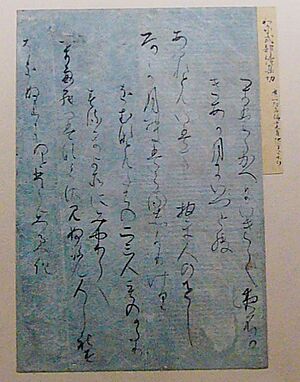Izumi Shikibu facts for kids
Izumi Shikibu (born around 976) was a very famous Japanese poet during the middle of the Heian period. She is known as one of the "Thirty-six Medieval Poetry Immortals," which means she was one of the best poets of her time. She worked at the court of Empress Joto Mon'in alongside other well-known writers like Murasaki Shikibu and Akazome Emon. Many people think she was the greatest woman poet of the Heian period. She left behind 242 poems and two poetry collections called kashu.
Contents
Her Early Life
Izumi Shikibu was the daughter of Oe no Masamune, who was the governor of Echizen Province. Her mother was the daughter of Taira no Yasuhira, the governor of Etchū Province. In 995, when she was about 20 years old, Izumi married Tachibana no Michisada. He was the governor of Izumi Province, which is where she got the "Izumi" part of her name. Their daughter, Koshikibu no Naishi, was born in 997 and also became a poet.
In the Heian period, women's names often combined a place name from their husband's job and a family title from their father. So, "Izumi" came from her husband's area, and "Shikibu" came from her father's official title, "master of ceremony."
Important Relationships
Izumi Shikibu had several important relationships at the imperial court in Kyoto. These connections often inspired her passionate love poetry.
She had a relationship with Prince Tametaka. After Prince Tametaka passed away, his brother, Prince Atsumichi (敦道親王, Atsumichi Shinnō, 981–1007), began to show interest in her. The first year of their relationship is described in her special diary. She wrote this diary to express her feelings and to record the poems they shared. Izumi later moved into Prince Atsumichi's home, and they had a very public relationship until he passed away in 1007.
Around 1009, Izumi joined the court of Fujiwara no Shōshi. Shōshi was the daughter of a powerful leader named Fujiwara no Michinaga and the wife of Emperor Ichijō.
Her Diary
Izumi Shikibu Nikki is the name of her diary. She wrote it at the beginning of her relationship with Prince Atsumichi, covering about nine months from 1003 to 1004. The diary is written as if someone else is telling the story. It includes many waka poems, with over one hundred poems, including some renga (linked poems). The diary shows how Prince Atsumichi sometimes seemed very interested and sometimes not, while Izumi felt shy and longed for him.
Her most important works are found in the Izumi Shikibu Collection (和泉式部集, Izumi Shikibu-shū) and in special imperial poetry books. Because of her life filled with love and strong emotions, Michinaga gave her the nickname The Floating Lady (浮かれ女, ukareme).
Other famous poets like Akazome Emon, Murasaki Shikibu, and Ise no Tayu were also at the court at the same time as Izumi.
Later Years
While at the court in 1009, Izumi married Fujiwara no Yasumasa (958-1036). He was a brave military leader. She left the court to go with him to his new post in Tango Province. She lived longer than her daughter, Koshikibu no Naishi, but we don't know the exact year Izumi Shikibu passed away. The last poem she sent to the Imperial court was in 1027.
Later in her life, she became very devoted to Buddhism. She wore special Buddhist robes for the rest of her life. Her Buddhist name was Seishin Insei Hōni.
Her Legacy
Izumi Shikibu's poems are still inspiring people today. For example, the Paris Opera and the Grand Théâtre de Genève worked together to create an opera based on her poems. This opera is called Da gelo a gelo by Salvatore Sciarrino and is sung in Italian. It uses 65 poems from Izumi Shikibu Nikki that show her strong feelings for Prince Atsumichi. It was performed in 2008.
Poetry Examples
Here are a few examples of her poems:
-
刈藻かき臥猪の床のゐを安み
さこそねざらめ斯らずもがな
karu mo kaki fusu wi no toko no wi wo yasumi sa koso nezarame kakarazu mo gana
The wild boar makes its bed by trampling dry grass and sleeps soundly. I would not sleep so peacefully, even if I didn't have these feelings.
(Goshūi Wakashū 14:821)
-
黒髪のみだれも知らず打臥せば
まづかきやりし人ぞ戀しき
kurokami no midaremo shirazu uchifuseba madzu kakiyarishi hito zo kohishiki
My black hair is messy; without a care, he lies down and gently smooths it first. Oh, how I miss that person!
(Goshūi Wakashū 13:755)
-
長閑なる折こそなけれ花を思ふ心の
うちに風はふかねど
nodoka naru ori koso nakere hana wo omou kokoro no uchi ni kaze wa fukanedo
There is never a calm moment. In the heart that loves the cherry blossoms, the wind is already blowing, even if you don't feel it yet. (This means that when you love something beautiful, you also worry about it ending.)
([1])
Many of her poems are about sadness or loss. Here are a couple of examples:
- To Prince Tametaka after his death:
亡人のくる夜ときけど君もなし
我が住む宿や魂無きの里
naki hito no kuru yo to kikedo kimi mo nashi wa ga sumu yado ya tamanaki no sato
They say the dead return tonight, but you are not here. Is my home truly a place without spirit?
(Goshūi Wakashū 10:575)
- After seeing her daughter Koshikibu no Naishi's name on her Imperial robes after she passed away:
諸共に苔のしたには朽ちずして
埋もれぬ名をみるぞ悲しき
morotomo ni koke no shita ni ha kuchizu shite udzumorenu na wo miru zo kanashiki
Beneath the moss, her famous name will not decay. Seeing it brings great sadness.
(Kin'yō Wakashū 10:620)
See also
 In Spanish: Izumi Shikibu para niños
In Spanish: Izumi Shikibu para niños



